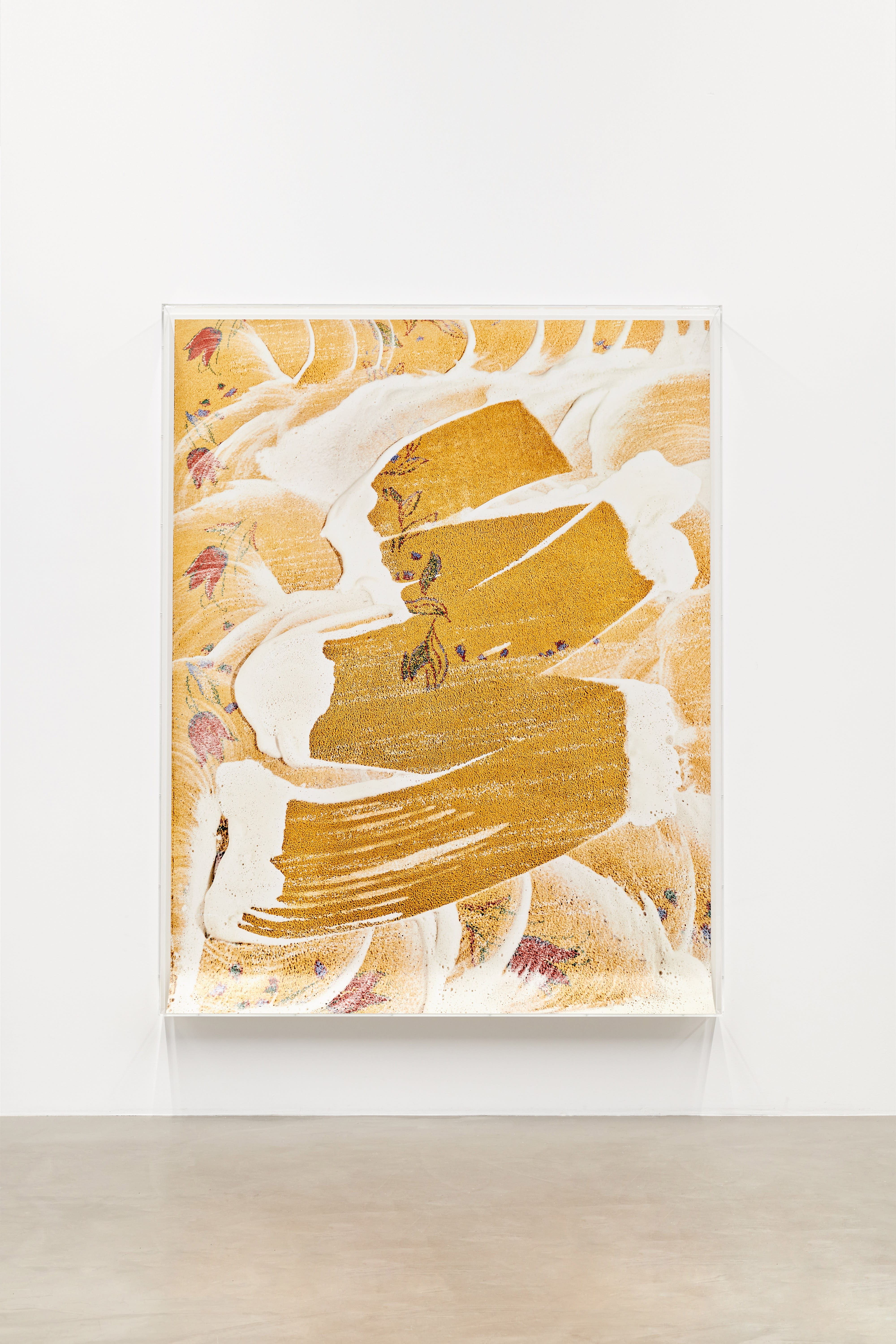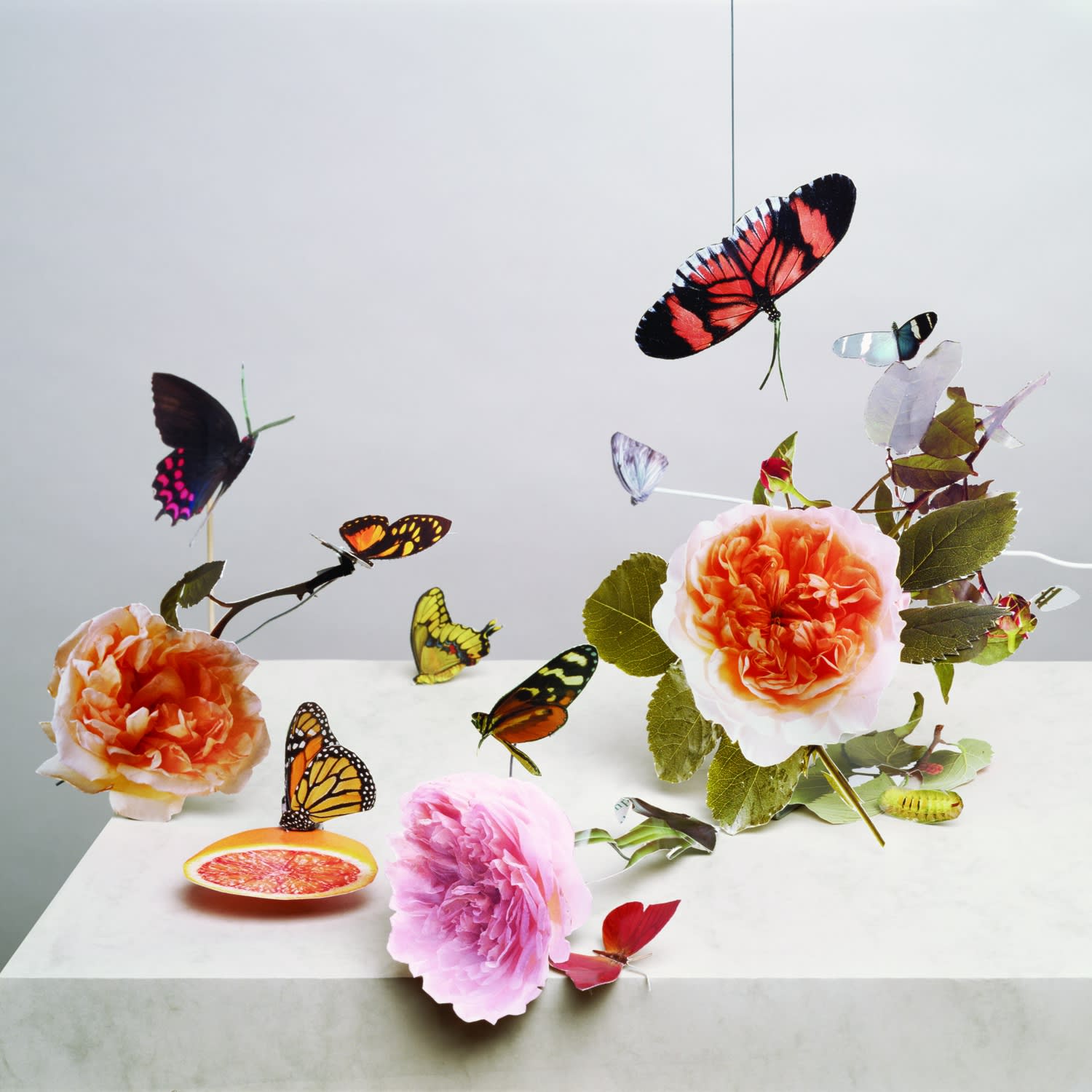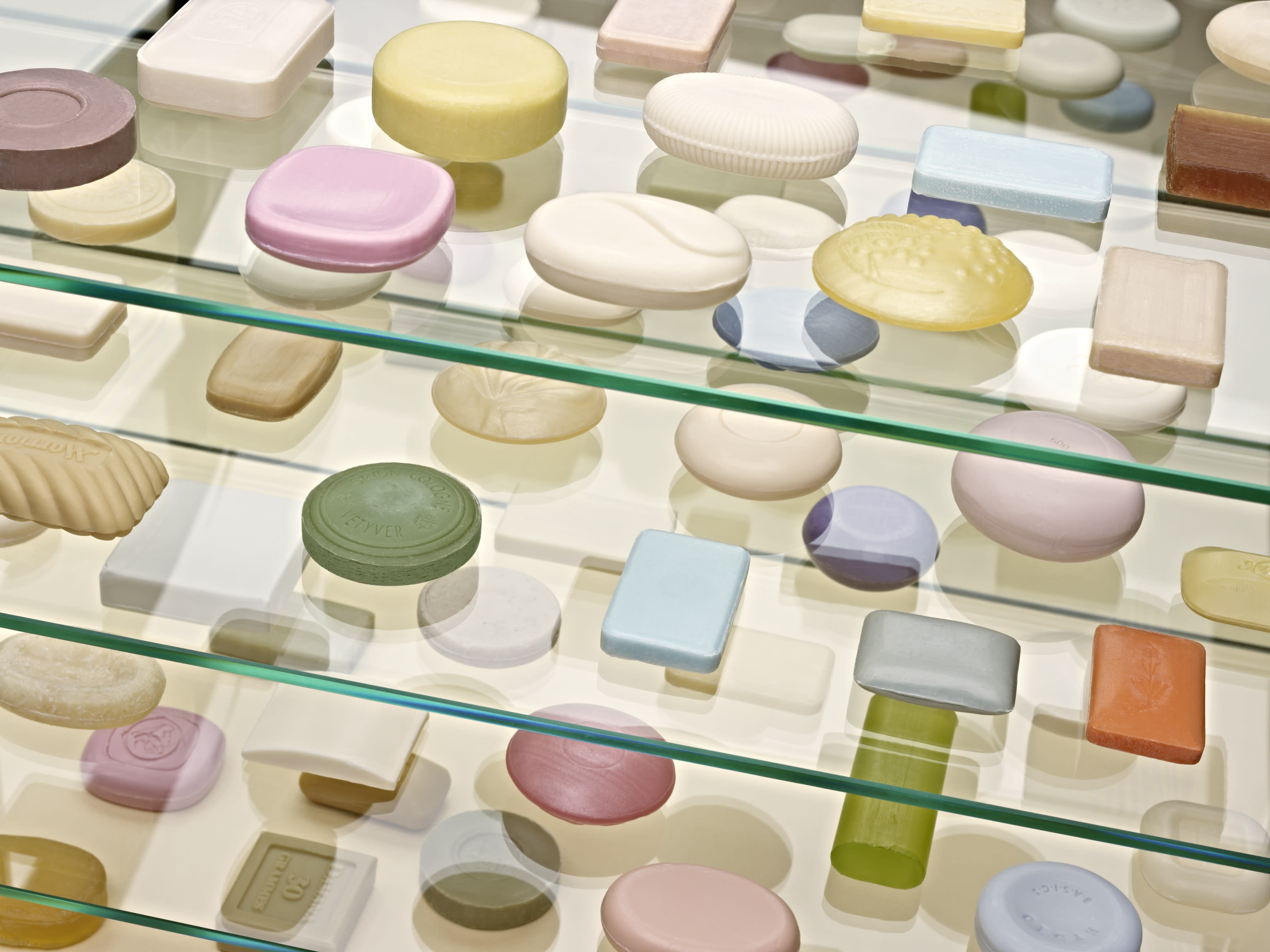"Our work is a game of recognition and alienation."
Last year photographers Maurice Scheltens and Liesbeth Abbenes were commissioned by design magazine MacGuffin to photograph rugs. “Their idea was to capture the story behind a stain on a rug. We thought that was too definite. So we just started cleaning the carpets. The final series is made of soap foam that lays over the carpet as a new decoration.” Abbenes: “Now it became a commentary on our own work, which is often seen as polished and clean.”

The Rug, Whiff #6 (MacGuffin Magazine), 2021 © Scheltens & Abbenes / courtesy The Ravestijn Gallery
This photo series is the starting point for the new solo exhibition Literally in the Ravenstijn Galerie in Amsterdam. For this, Scheltens & Abbenes return to the three-dimensionality of the carpets. The original photos, the size of which was limited by the size of the magazine, have now been blown up to a considerable size and encased in some Plexiglas boxes. As a result, the heavy prints lean against the back and slightly curl up at the bottom.
“We want to reorganize the world into a calm and pleasant image. At the same time, we want to show the world as you have never seen it before. It is a game of recognition and alienation.” - Liesbeth Abbenes
Basic scenography
The photographic still lifes of Scheltens & Abbenes are made up of the objects, interiors and installations. They use these objects 'literally', as they say themselves. Hence the exhibition title Literally. They are also very reserved with the retouch. “We always take the first original with the final image. Is it still right? Has anything been lost in the process of styling and not?”
The compositions that the duo creates with these literal objects are colorful and full of graceful shapes and surprising details. Often slightly strange too. Scheltens: “The scenography we make is quite rudimentary. If you are going to build and decorate a complete set but the result is not completely satisfactory, there is always the risk that you will get started with it because of all the effort you have already put into it. That can be time consuming.” Abbenes: “If something good comes out, hey. Because usually the end result is also unsatisfactory.”

Artis Magistra, 2006 © Scheltens & Abbenes / courtesy The Ravestijn Gallery
Sometimes it is no more than a few planks on bricks they work with in their home studio in Amsterdam-Noord. The lighting is also often quite basic. “The magic has to come from looking and looking for the right distance, color combination.” They see that as the beauty of photography: “Creating a world that doesn't have to exist in real life."
It's not hard rules, though. For example, they have built large installations for Paco Rabanne and that worked well. Abbenes, laughing: “You see, you shouldn't make too many rules for yourself.” But they would never accept an assignment in which they have to document objects belonging to someone else. “We want to add something to what is already there, so that the result is entirely ours,” says Abbenes.
Pharrell Williams
Scheltens & Abbenes, living and working in Amsterdam-North, are long and broad among the world's best photographers of both commercial assignments and free work. “In our work it is not immediately clear whether it is an autonomous object or an applied work. It has an openness," says Scheltens. Indeed, the photo duo seemingly effortlessly alternates an editorial for the New York Times with a commercial for Human Race, the cosmetics brand of pop icon Pharrell Williams.
Abbenes: “A good assignment can be stimulating. Then it becomes exciting, within the framework of what the customer wants, what we want and the… material say that you are provided.” Whatever they make, they are always works that survive without the commercial context, says Scheltens. “It is also often a short period of time in which a work is created. Assignments sometimes have to be completed within a few weeks. There is then at most one week for the actual photography. But in the end we always work towards that one moment of printing. We like working that dynamic.”
Functional Art
You could also call the work of Scheltens & Abbenes “Functional art”. Details matter in the life and work of these masters of form-color-measurement, the holy trinity of the arts. Both in clothing and in choice of words are both extremely well cared for. It cannot be a coincidence that they work together as lovers. The mutual chemistry is visible through their different backgrounds. After meeting in 2000, they started working together two years later. “I studied visual arts at the Rietveld Academy and then at the Rijksacademie. I am trained to be able to work on my own.”

COS Collections / Soap Bars , 2012 © Scheltens & Abbenes / courtesy The Ravestijn Gallery
“That is very important to us, that you can always see something new in our photos.” - Maurice Scheltens
Scheltens studied photography at the KABK in The Hague. His career began with carefully composed advertising photos. “Liesbeth embroidered wall hangings. We both worked down to the millimeter. Very careful too, with constant looking, from a distance, up close. Working together was the logical step. But I can still pull Liesbeth back to a more applied, almost commercial way of working if she gets too conceptual.” Abbenes: “And vice versa! In this way we keep each other in balance, almost like a game of chess. It is precisely this duality that gives our work a certain tension.”
Flower Auction in Aalsmeer
The duo makes almost cuddly still lifes with a lively color palette. The objects can be grainy and coarse, or shiny and smooth. Hard and soft, with a hint of recognition, but also abstract, because you zoom in very sharply or choose a wide perspective in which proportions are lost and distinctive details blur. The size of the photographed objects remains a mystery, as does the distance to the lens. “That is very important to us, that you can always see something new in our photos,” says Scheltens. As a result, you as a viewer are constantly confronted with your perception: do I see what I see? Abbenes: “We want to reorganize the world into a calm and pleasant image. At the same time, we want to show the world as you have never seen it before. It is a game of recognition and alienation.”

Trailer #4: Red Anemone, 2016 © Scheltens & Abbenes / courtesy The Ravestijn Gallery
Applying a layer over reality, that is the essence of photography for Scheltens & Abbenes. Take their photo series of the colorful flower decorations on trucks at the flower auction in Aalsmeer. Abbenes: “Sometimes these are photo prints of flowers, sometimes an airbrush painting or just a sticker. And then you also see the relief of the truck tarpaulin. What the painting is, what the sail and what we add with our lens, is hardly distinguishable. Something new has emerged.”
Commercial and autonomous
They rarely have to fight for this artistic freedom. “The clients who approach us choose us very consciously because of how we work. We also don't want them there when we do the shoot. Suppose such a person just says: hmmm I like gray just as much. Then you can…. aaargh, being so annoying”, says Abbenes.
“We want to reorganize the world into a calm and pleasant image. At the same time, we want to show the world as you have never seen it before. It is a game of recognition and alienation.” - Liesbeth Abbenes
Also, sometimes it's good to say no. “We even turned down The New York Times at one point. Afterwards we thought: Oh no, what have we done?! But then they came back with an assignment that suited us much better. It's important to stay true to the way you work.” Scheltens: “Finding a balance between commercial and autonomous also took us years. And we still have to stay sharp.”

